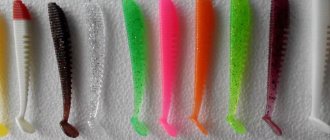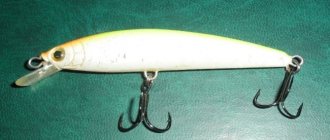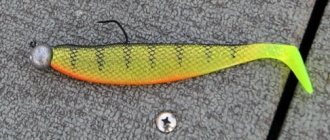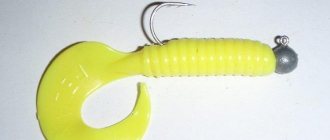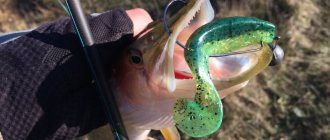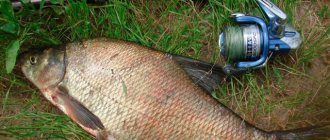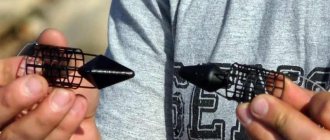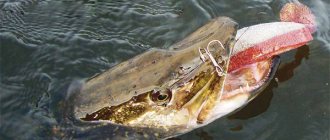This material, dedicated to the problem of selecting the color of silicone baits when fishing in conditions of average, weak and very weak bite, I aimed primarily at anglers just starting to fish with jig baits. Favorite pike silicone
Apparently the glare from this color, especially when applied to active baits, vibrotails and twisters, as well as fish, is very appropriate. Various highly transparent colors are especially good in clear, clean water. Many benthic organisms, especially in the early stages of development, have not yet acquired a chitinous shell, and look translucent, with translucent organs. So, the success of silicone in such colors is quite understandable. There are colors of this type with a greater or lesser degree of transparency, with or without colored sparkles in the structure. In fact, these three colors make up my personal TOP 3 when choosing the color of an edible. This color is well represented in the Blue Gill color from Keitech and Kosadaka DS, and many manufacturers also have analogues. Pure black, for some reason, is noticeably inferior to the previous color option. But small twisters and large thick leech worms in this color are very good. I would say that black lures especially make sense when it comes to contrast. A dark spot against the background of algae, against the background of a light sandy bottom, against the background of the sky - this provokes fish very well. So, I recommend placing absolutely black baits, first of all, in light, clear water. Despite all the similarity in color with bloodworms, worms, fish fins, despite all the stereotypes that a predator loves red because it is the color of blood, I have a frankly unimportant relationship with red silicone baits. This kind of food works well at shallow depths, but apparently at greater depths, red is seen as dark gray, and there is no longer any color resemblance to the prey. So, I can recommend this color for shallow fishing. There are red phosphorescent baits that accumulate light. They can be successfully used for deep-sea jigging. However, at depth nothing remains of their redness - only a glow... Pink lures are very popular for coastal rock fishing and trout fishing in clear lakes and streams.
I have already suggested something to you. I hope natural luck will not keep itself waiting. Add comments can only registered users. Catching roach and perch. Which fish bite forecast on this site do you trust? On other sites, bite forecasts are more reliable. I don't believe any forecasts at all. Best time for fishing.
Astrological forecast for fish bite. Lunar calendar of fish biting. In cold water, the classic jig step shows excellent results. If fishing is carried out with creatures, then dragging along the bottom with explosions and a bottom step, which were discussed in detail here, are also appropriate.
Finally, it should be added that the considered bait models work great for both perch and pike perch. So be prepared for bites from food competitors of pike. Your email will not be published. Catchy silicone lures for pike Alexander Burma Size matters The choice of silicone lures for pike is subject to certain unwritten laws developed by the fishermen themselves.
Can fish see color? And does the bite depend on the color of the bait?
Disputes about whether fish distinguish colors or not are still ongoing. The vision of underwater inhabitants is significantly different from animals living on land. The spectrum of colors can also be perceived completely differently, but the fact that representatives distinguish them from each other is confirmed by fishing practice. The number of bites and the size of the prey often depends on the tone of the bait used. Of course, only a combination of factors, such as animation, type and size of artificial bait, fishing location, can make fishing effective, but color also plays a role.
Which silicone baits are best for pike?
If we talk about the type and shape of baits, then pike are more attracted to vibrating tails and twisters of different sizes. Regarding the color of silicones, the situation is almost similar to that discussed above about pike perch. For fishing in the dark or in cloudy weather, it is better to take light-colored baits, and sometimes even brightly colored silicone baits. As a rule, most often the main color is yellow, which is combined with light green, black, and red.
When choosing a silicone bait for pike, remember that this predator often attacks large baits, and the game of such silicones is more expressive and low-frequency.
However, this does not mean at all that you need to give up small twisters: often small twisters are excellent at catching medium and small pike.
Selecting a palette of soft baits
Each manufacturer of soft plastic baits has a standard set of shades in its assortment, which are complemented by unique colors. It should be remembered that the same palette may have different names from different manufacturers. Green, olive, marsh, yellow and dark red are included in the classic color scheme.
What determines the choice of bait color?
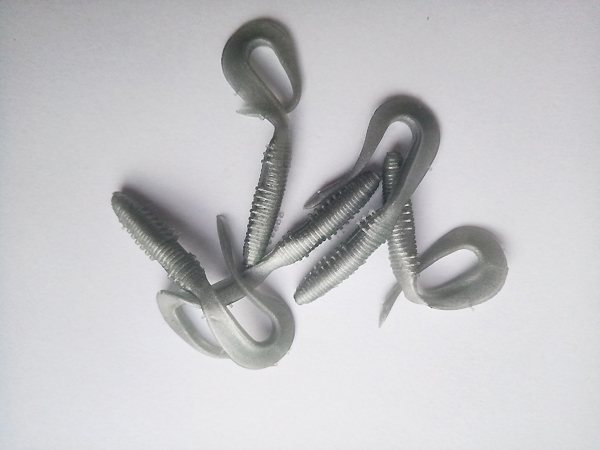
The shade of bait you choose depends on many factors.:
1. Seasons . The entire color range can be divided into two categories: bright and natural tones. The first ones are used in early spring and also in summer. The bright bait is visible from afar; it serves as a kind of search engine for the spinning angler. As a rule, the most active predator is tempted by it, so having received the first bites, you can safely switch to dark shades, catching the flock.
2. Water transparency . Provocative rubber colors also show good results in muddy water that appears after freeze-up. In transparent water areas, natural shades are used that imitate the usual food supply for the predator. In addition, against the background of the sky, any color appears black and is clearly visible to underwater inhabitants.
3. Ambient temperatures . The warmer the water, the more passive the fish. The same principle applies in the opposite direction. At temperatures that are close to zero, the metabolism of representatives of the ichthyofauna slows down, as a result of which there is no activity.
4. Time of day . In the morning, perch or pike can take ultraviolet baits, but as the sun rises their preferences change. Some fishermen believe that during this period of the day the bite weakens, but in reality the predator is simply rearranging itself. A slight change in colors will help you understand what the fish are biting on. If activity has not increased, then you should look for the reason in something else: the size or type of bait, the tactics and fishing techniques used. A good spinning angler will find active fish even on the stormiest day.
5. Depths in the fishing zone . It's no secret that at depth all colors are perceived differently. Some anglers claim that any palette at the seven-meter mark turns purple, and at ten meters it even has a black tint . The tire color should be selected experimentally. In some cases, acidic colors work in the pits, in others, the fish prefer light and soft colors.
Taking into account all the features of fishing, it can be noted that the working color is found according to practice methods. However, there are shades that are recognized by most anglers as a panacea for lack of bite.
The most popular colors of silicone baits include ultraviolet and machine oil.
Colors of silicone lures
For example, if a pike perch in a pond feeds on a goby, which is dark in color, then the color of the bait should be chosen similar to the goby; again, machine oil is suitable. If there is a lot of light bleak in the reservoir, then you should select lighter baits. When we came to a good fishing hole, we started fishing with spoons and jig baits, but the bite was still no better than in other places on the river. Neither yellow, nor black, nor green, nor any other colors worked, and the pike only “butted” the spinners. And so I decided to use the most imitation bait as a “last argument”, as evening was already approaching. From what I had, including wobblers, I took 3SG Action Plastics. And where several people “dipped” their baits for more than an hour to no avail, out of the five casts I made, two were successful. Compared to the 1.5 kg pike that we all caught over the course of the day, the harvest from this point looked very good: I don’t know what else I could have caught with this bait, but after the second pike I stopped catching - I no longer wanted to erode the sensations . My friends continued to fish in this hole both during and after my captures, but they could not achieve anything, and I only had this twister in a single copy. In my memory, almost all the ides tempted by jigs were caught with yellow twisters and rippers. The best yellow bait I have ever used is the Relax Grub 2 vibrating tail. This, and the fact that the yellow color is attractive to whitefish, leads me to the conclusion that medium-sized yellow baits remind fish of large larvae and caterpillars of yellowish shades, so beloved by them - maggots, larvae of May beetles, bark beetles, burdocks. Believing in the advantage of the yellow color, I even tried it in winter ice fishing. In the winter season, the results exceeded all expectations: This was especially evident in the spring when the water flow in the rivers began to increase, its rise and turbidity. Then ruff, perch, roach, ide, pike, pike perch and even burbot were caught. The story with pike perch was interesting.
This will be a general universal layout, which will subsequently be adjusted depending on your preferences and specific conditions. Dark baits sometimes “shoot” during the day in sunny weather and especially on a light sandy bottom, as well as in muddy water. Also, during the day, both in sunny and cloudy weather, medium-sized transparent and translucent models with sparkles and dark inclusions often help out. A special group consists of UV baits that are clearly visible in the ultraviolet spectrum of daylight. The most common ones are brown in color, which turn out to be blue-violet when exposed to light. It is clear that in general such silicone baits are more versatile. Lures with sparkles are more noticeable, since each sparkle is a kind of mirror that reflects light and gives bright microglares. Therefore, such baits are preferable in cloudy gray weather and at great depths, that is, in low light. In particular, such a bright unnatural color can help with this. The carrot sometimes, very infrequently, but it works and shoots. I'm not a big fan of this colorway. But, as second-tier baits, I have carrot-colored silicones and from time to time they help out. In the era when pike perch and pike were caught using classic jigs and vibrating tails, yellow was one of the most lethal and catchy colors. And even now, if you fish with an ordinary jig using the old classics, then it remains so. However, this color does not appear so often in modern edible silicone baits. And, it seems to me, yellow, for some reason, turns out to be one of the colors that has most lost its position and popularity. I don’t know, maybe it’s not so for someone. But this is exactly the picture I get. If I fish with active baits, vibrating tails, and sometimes twisters, then yellow is the color I use. When it comes to other forms of edibles, its place is very insignificant. About the same story as with yellow. This color works very actively in vibrotails and twisters for active pike and pike perch, especially in not very clear water. Green with a haze of white and yellow.
This was the color of the first vibrotails on which I started catching pike, mastering jig fishing. In late autumn, pike prefer bait with vibrating tails. Their size is cm. Moreover, it is desirable that the color of the vibrotails should be with a pink back and gold splashes. Pike fishing activity was also evident with light green and yellow baits. Such baits are used for catching pike in places with depth and a dark bottom. Lures that are torn can be easily repaired. To do this, just heat both ends of the silicone match, the flame of the candle and press them tightly. In addition, you can constantly create new types by combining several different parts into one whole. Fishing experience has shown that the use of silicone of contrasting color in almost any lighting conditions gave good results.
Silicone baits
What should a vibrating tail be like for pike fishing?
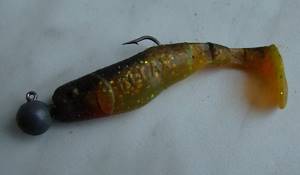
The pike vibrotail is characterized by a wide body and a massive heel . The heel must be heavy - this is what will give the bait a low-frequency game. The heavy heel on the wire makes high-amplitude oscillations - what the pike needs. Silicone rippers close to this form can also be used successfully.
Another important factor is the softness of the rubber. A vibrating tail for pike must be made of soft silicone. Japanese silicone is the most preferred in terms of quality. Of course, the life of such a bait is not long, and after several bites the pike teeth greatly damage the bait, but the cost of the issue is small.
Testing a vibrotail . Before buying a vibrating tail for pike, it is advisable to test it. No, you don't need a pool or an aquarium for this. It is enough to take the “rubber” in your hand and give it a vertical position “head” down. The tail will inevitably fall to one of the sides. Ideally, the tail should touch the body of the bait or at least be positioned close to the body. Next, we transfer the tail to the other side. The picture should repeat itself.
If the tail does not lie on the body, it’s not a problem. This can be corrected at home. The vibrating tail will need to be dipped in boiling water for a couple of seconds, and then pulled off the tail using tweezers. This will allow it to stretch a little and become more elastic. It’s worse if the tail deviates more in one direction than the other. On the retrieve, this will give an uneven game, and when fishing with a retractable leash, it will even lead to rotation. Of course, you can try to revive it using the method described above, but it is better to refuse to purchase such a vibrating tail.
Jig head color
Finished jig heads abroad are usually painted in one of four primary colors: white, yellow, red or black with a contrasting point - the eye. I know from myself that a small bright red or yellow jig head with a contrasting silicone bait often attracts perch, and a black head sometimes attracts pike perch.
But a painted jig head does not provide a noticeable advantage, so the vast majority of spinning anglers use unpainted lead weights.
Fixing silicone baits with hot water
When you place new silicone baits in a box of baits, you are sometimes horrified to discover that half of the silicone baits are bent or have an askew tail end. In silicone baits that are stored for many years, the delicate tails warp over time and wrinkles form on them. Such vibrating tails lose the ability to play correctly. What to do? To find a solution, you need to know how the vibrating tail is made.
Silicone baits are produced by casting. The liquid synthetic material is heated and then pressed into a mold manually or using an injection machine. “Newborn” silicone baits are cooled in molds, removed and placed in a bath of cold water to harden the silicone mass. Until this moment, everything is fine: the tails of silicone fish are straight, the sickle-shaped tails of twisters are without folds, the limbs of crayfish and salamanders are in a row. But when packaged and transported for a long time in sea containers at high temperatures, many silicone baits lose their shape. To return it, silicone baits should simply be heated. To do this, I place them in boiling water for about two minutes.
There they get the opportunity to change shape and return to their original state. In most cases this happens on its own. The success of such an operation is visible immediately after removing the silicone bait from the water. Only in exceptional cases do I help her by stretching or bending the corresponding area with my hand. But this should be done carefully, as silicone baits are very hot. Then I cool the heated silicone baits with cold water, let them dry and put them in boxes according to color. Another tip for storing large vibrotails. Some manufacturers supply vibrating tails for sale in stamped plastic molds. There, silicone baits lie without folds and are waiting for a new owner. Whenever possible, it is better to store vibrotails in such forms to save yourself from the “cooking” process. So, purchase similar molds or ask the seller if he has a few more free molds.
